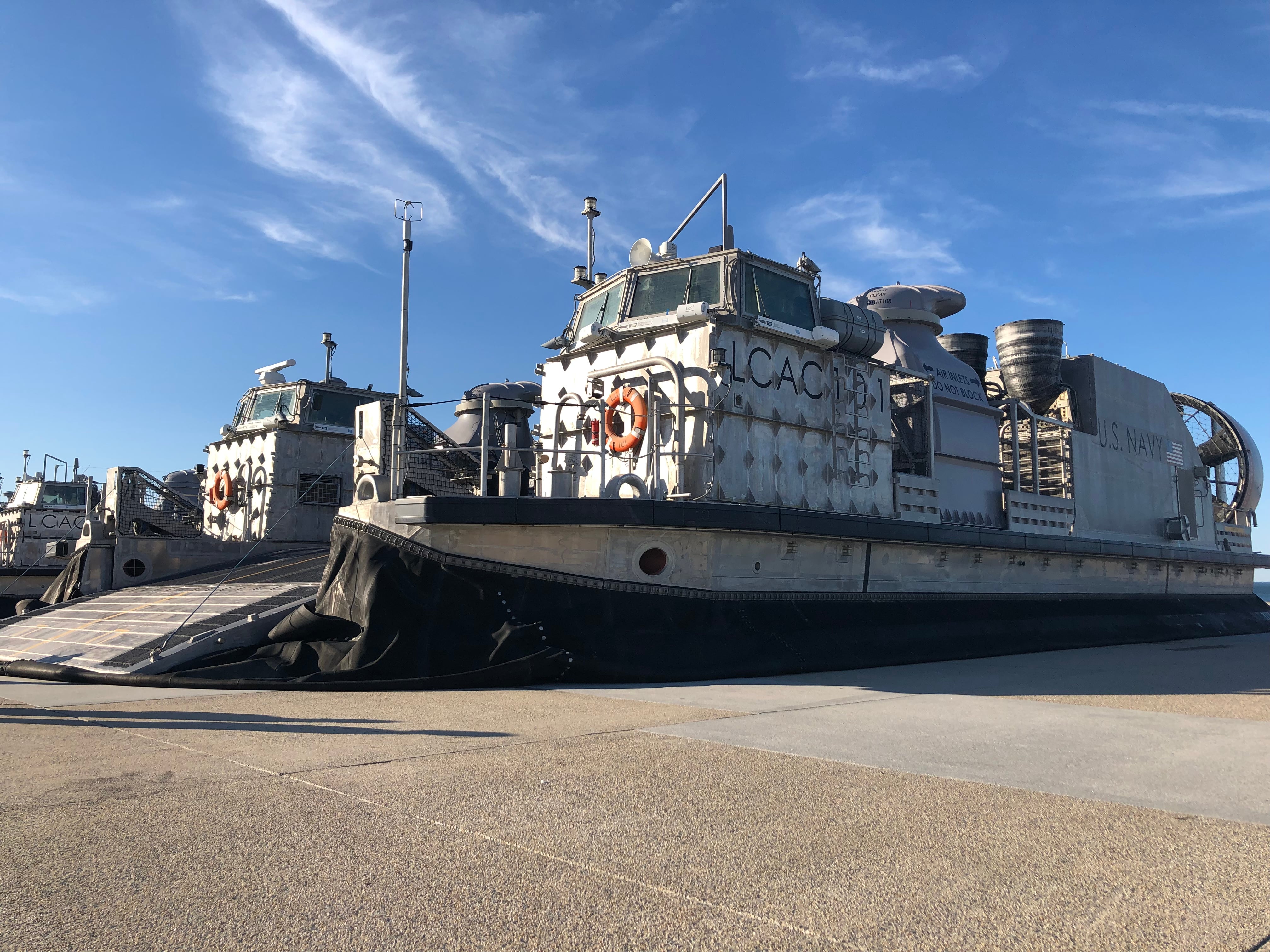VIRGINIA BEACH, Va. — Two of the next-generation Ship to Shore Connector craft arrived Friday at their new home: Assault Craft Unit 4 at Joint Expeditionary Base Little Creek-Fort Story in Virginia.
Now, the goal for the Navy is getting sailors in the unit up to speed on how to operate these craft, which are designed to carry personnel, cargo, weapons systems and other Marine Corps assets from ship to shore.
The connectors, known as Landing Craft Air Cushion 101 and 102 ( or alternately, SSC 101 and 102), feature updates to improve maintenance and carry heavier payloads in comparison to the legacy LCACs they will replace, Navy officials said. The SSCs can carry up to 74 tons — up from the 60 tons the legacy LCACs can haul.
“Marine Corps craft, wheeled vehicles and everything have gotten heavier over the years, and so it’s really important that these new craft have the ability to carry more payload,” Capt. Scot Searles, the amphibious assault and connectors program manager, told reporters. “And so that’s one of the other great things … we put more power into the craft and they can carry more now.”

While the Marine’s Corps’ is shifting its focus to the Pacific and expeditionary advanced base operations, the mission of these new craft remains unaltered and the objective is still to support hauling Marine Corps elements, Searles said.
“Air cushion technology allows this vehicle to reach more than 70 percent of the world’s coastline, while only about 15 percent of that coastline is accessible by conventional landing craft,” according to Navy Sea Systems Command. “In addition to beach landings, LCACs provide personnel transport, evacuation support, lane breaching, mine countermeasure operations, and Marine and Special Warfare equipment delivery.”
LCACs 101 and 102 are the first craft of their kind delivered to operational units, and the Navy is aiming for them to reach initial operational capability in 2023 before deploying in 2024.
The craft have undergone years of testing and evaluation, including overland testing at Eglin Air Force Base in Florida and controlled damage testing to see how they would fare in the event of a mine explosion.
Most recently, the craft wrapped up well deck interoperability testing with the dock landing ship Carter Hall this month in Panama City, Florida, allowing the Navy to launch an initial phase of ship interface testing as the craft conducted entries and exits from the ship.
“At the end of that testing, after a bunch of entry and exits, then these two craft came on board and we tied them down and brought them up here” to Little Creek, Searles said.
Although there is still more testing the craft must undergo, the “real focus” upon delivery to the Assault Craft Unit 4 is getting sailors trained to operate them, Searles said. Previous testing events only involved civilians and sailors from ACU 4 who traveled to Florida.
“In addition to the testing events, we need to train our sailors on how to operate these craft,” Capt. Tony DeFrias, commanding officer of Assault Craft Unit 4, told reporters. “Up to this point, we have a very limited number of sailors that have had the opportunity to learn these craft and that’s what we’ll be doing in the very, very near future.”
Although the dimensions of the craft are similar to their predecessors for compatibility purposes, there are several changes that present a learning curve for those accustomed to the legacy models.
According to Senior Chief Rafael Fana, an SSC pilot, the new craft’s design has “totally reconstructed the way you do business up there.”
Whereas the legacy LCACs have a crew consisting of craftmaster, engineer, navigator, loadmaster and deck engineer, the next generation craft have shifted the manning roles slightly. As a result, the crew for the new craft include a pilot, copilot, loadmaster and two deck engineers.
For Fana, who was involved in the testing and evaluation work in Panama City and already has approximately 60 hours in the pilot seat of the new craft, that means assuming additional navigation responsibilities.
“I have an engineering background. I don’t have a navigation background. So they combine two seats into one: engineering and navigation,” Fana, who has served in the Navy for more than 25 years, told Navy Times. “So, whether your background is one or the other, you may not be as strong on that side as the other. So that’s my learning curve, since I’ve never dealt with a lot of navigation and radios.”
Even so, Fana said piloting the craft on open water is a piece of cake — a new “luxury” in comparison to the legacy craft.
Two SSCs were delivered to the Naval Surface Warfare Center Panama City Division in Florida in both 2020 and 2021, including the two that arrived at Little Creek Friday, but the goal is for contractor Textron to deliver four annually. At the annual Surface Navy Association conference in January, Searles said he anticipates that rate will be met this year.
“We’ve got a nice full production line now, so the pump is fully primed and now there’s no longer anything backing it up at the exit,” Searles said. “I think we’ll get to four this year — if not, it will be three with one that just barely misses being in this year.”
“So I think 2023 we’ll see four craft deliveries and I would expect to see that going forward at a very steady rate,” Searles said.
Subsequent units slated to receive the new craft are Assault Craft Unit 5 at Camp Pendleton, California, and Naval Beach Unit 7 in Yokosuka, Japan.
The Navy aims to purchase 72 craft total, and Textron was awarded two contracts for the first 24 craft. The service will issue another contract proposal request later this year, Searles said in January.





